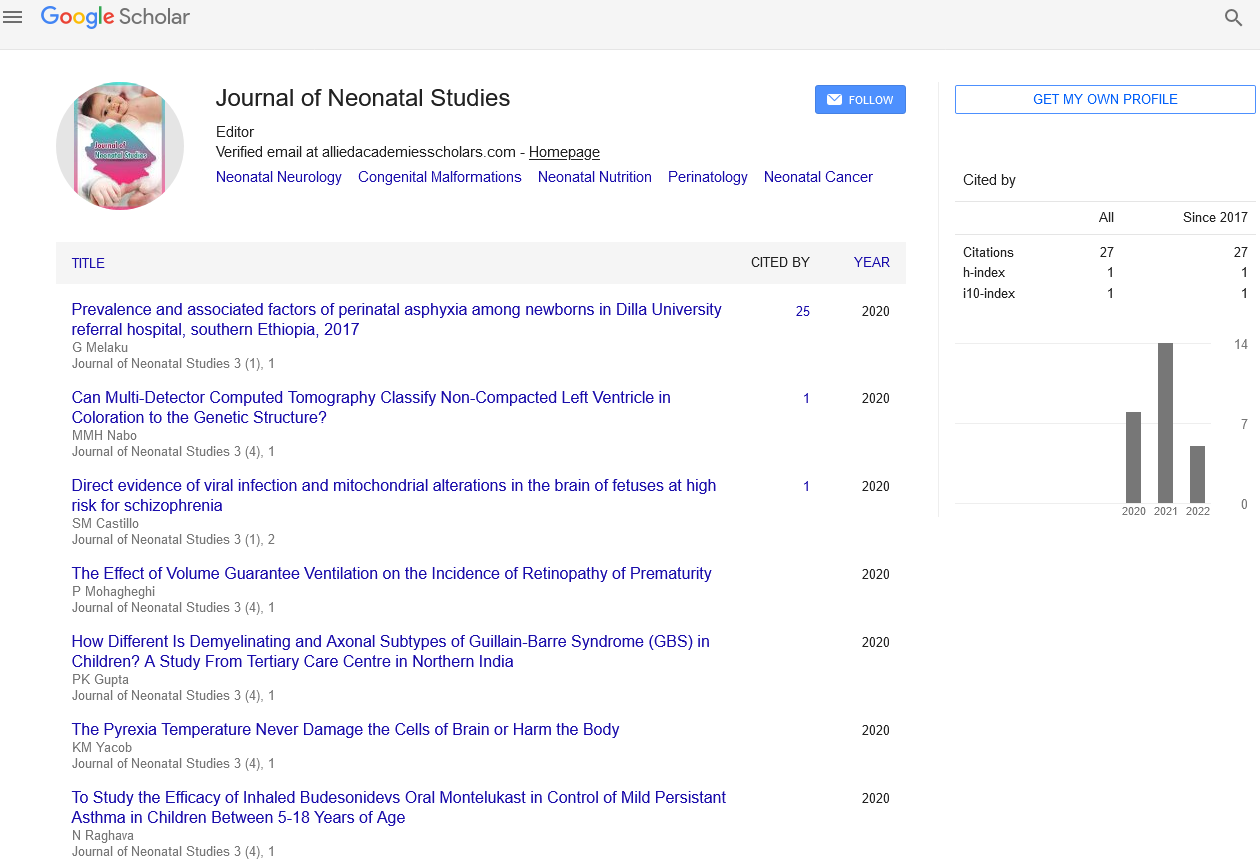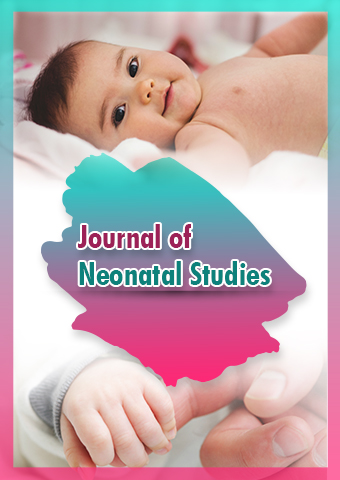Review Article - Journal of Neonatal Studies (2023) Volume 6, Issue 2
A Review on Neonatal cancer
Panayides Andreas*
Department of Computer Science, University of Cyprus, Nicosia, Cyprus
Department of Computer Science, University of Cyprus, Nicosia, Cyprus
E-mail: andreas.p@edu.cp
Received: 01-Apr-2023, Manuscript No. jns-23-96932; Editor assigned: 03-Apr-2023, PreQC No. jns-22- 96932(PQ); Reviewed: 17-Apr-2023, QC No. jns-22-96932; Revised: 21- Apr-2023, Manuscript No. jns-22- 96932(R); Published: 28-Apr-2023; DOI: 10.37532/jns.2023.6(2).50-52
Abstract
Neonatal cancer refers to any type of cancer that is diagnosed in a child under the age of one year. This type of cancer is rare and accounts for less than 1% of all childhood cancers. Neonatal cancer can occur in any part of the body, and the diagnosis and treatment of this disease can be very challenging. Neonatal cancer is a broad term that encompasses several types of cancers that occur in infants. The most common types of neonatal cancer include neuroblastoma, hepatoblastoma, retinoblastoma, and leukemia. Neuroblastoma is the most common type of cancer that occurs in infants, accounting for nearly 50% of all neonatal cancer cases. This type of cancer originates in the nerve cells that are present in the embryo or fetus. Hepatoblastoma is the second most common type of neonatal cancer and occurs in the liver. Retinoblastoma is a rare type of cancer that occurs in the retina of the eye. Leukemia is a cancer of the blood and bone marrow and can occur in both infants and older children. The causes of neonatal cancer are not well understood. In many cases, the disease appears to be caused by genetic mutations that occur in the developing fetus. Certain genetic conditions, such as Down syndrome and Beckwith-Wiedemann syndrome, increase the risk of neonatal cancer. Exposure to certain toxins or chemicals during pregnancy may also increase the risk of neonatal cancer.
Keywords
Neonatal cancer • Neuroblastoma • Leukemia • Brain tumors • Blood cells • Bone marrow
Introduction
Neonatal cancer refers to cancer that occurs in new-borns and infants up to 28 days of age. Although neonatal cancer is rare, it is a devastating disease that can affect the baby’s overall health and development. Due to the rarity of the disease, research into neonatal cancer is limited, and treatment options are often based on the treatment of similar cancers in older children and adults. There are several types of neonatal cancer, including neuroblastoma, leukemia, and brain tumors. Neuroblastoma is the most common type of neonatal cancer, accounting for approximately 50% of all cases. It arises from the developing cells of the sympathetic nervous system and can occur anywhere in the body, but most commonly in the abdomen. Leukemia is the second most common type of neonatal cancer, accounting for approximately 30% of cases [1].
It is a cancer of the blood cells and can be either Acute Lymphoblastic Leukemia (ALL) or Acute Myeloid Leukemia (AML). Brain tumors are the third most common type of neonatal cancer, accounting for approximately 10% of cases. The causes of neonatal cancer are not well understood, but several factors may increase the risk of developing the disease, including genetic mutations, exposure to certain chemicals or radiation, and maternal exposure to certain infections during pregnancy. Symptoms of neonatal cancer can be nonspecific and may include a lump or swelling, fever, irritability, poor feeding, and lethargy. Diagnosis of neonatal cancer is challenging due to the age of the patient and the nonspecific symptoms. Medical professionals may use a combination of imaging tests, such as ultrasound, MRI, and CT scans, and laboratory tests, such as blood tests and biopsies, to make a diagnosis [2].
Treatment of neonatal cancer often involves a combination of surgery, chemotherapy, and radiation therapy. However, due to the young age of the patient, treatment options may be limited, and the potential side effects of treatment can be severe. The goal of treatment is to cure the cancer while minimizing the impact on the baby’s overall health and development. Neonatal cancer, also known as infant cancer, refers to cancer that is diagnosed in the first 28 days of life or during the neonatal period. Although relatively rare, neonatal cancer is a devastating diagnosis for parents and caregivers. Due to its rarity, neonatal cancer is often under-researched and underfunded compared to other types of cancer [3].
Neonatal cancer can arise from any type of tissue in the body and can manifest in different ways, including solid tumors or cancers of the blood, such as leukemia. Some of the most common types of neonatal cancer include neuroblastoma, hepatoblastoma, and retinoblastoma. Diagnosing and treating neonatal cancer presents unique challenges, as infants bodies are still developing and their organs are more sensitive to the side effects of chemotherapy and radiation therapy. However, advances in medical technology and research have led to improvements in treatment options and survival rates for some types of neonatal cancer. Despite these advances, neonatal cancer remains a serious and life-threatening condition, and there is still much to be learned about its causes and treatments. This highlights the need for continued research and advocacy to improve outcomes for infants with cancer and their families [4].
Discussion
Symptoms of Neonatal Cancer
The symptoms of neonatal cancer can vary depending on the type of cancer and the location of the appetite, irritability, and lethargy. Other symptoms may include a lump or mass that can be felt under the skin, swelling in the abdomen or other parts of the body, and changes in bowel or bladder habits. Diagnosing neonatal cancer can be difficult, and doctors may need to perform several tests to confirm the diagnosis. These tests may include blood tests, imaging studies, and biopsies. Because neonatal cancer is so rare, it is often misdiagnosed or diagnosed at a later stage, which can make treatment more challenging. Treatment for neonatal cancer can vary depending on the type of cancer and the location of the tumor. In many cases, surgery is the primary treatment for neonatal cancer. Chemotherapy and radiation therapy may also be used to shrink the tumor or to kill cancer cells that may have spread to other parts of the body. However, because infants are so young, the use of chemotherapy and radiation therapy can be challenging, and doctors must be careful to minimize the risk of side effects [5].
The prognosis for neonatal cancer can also vary depending on the type of cancer and the stage of the disease at the time of diagnosis. In general, the prognosis for neonatal cancer is not as good as it is for childhood cancers that occur in older children. However, with early diagnosis and aggressive treatment, many infants with neonatal cancer can be successfully treated [6].
Conclusion
Neonatal cancer is a rare and challenging disease that can occur in infants. The causes of neonatal cancer are not well understood, and the symptoms of this disease can be non-specific. Diagnosis and treatment of neonatal cancer can be challenging, and doctors must be careful to minimize the risk of side effects associated with chemotherapy and radiation therapy. Despite these challenges, with early diagnosis and aggressive treatment, many infants with neonatal cancer can be successfully treated. Neonatal cancer is a rare but devastating disease that can affect the health and development of new-borns and infants. Although research into neonatal cancer is limited, advances in medical technology and treatment options have improved the outlook for affected infants. Early diagnosis and prompt treatment remain crucial for the successful management of neonatal cancer [7, 8].
Neonatal cancer is a rare and devastating disease that affects new-born babies. Despite the advancements in medical technology and research, neonatal cancer remains a challenging condition to diagnose and treat. The early detection of cancer in new-borns can be difficult, as symptoms are often non-specific and can be attributed to other conditions. The treatment of neonatal cancer usually involves a combination of surgery, chemotherapy, and radiation therapy. However, these treatments can have significant side effects, especially in new-borns, and can impact their development and quality of life. While the overall prognosis for neonatal cancer is generally poor, there have been some successes in recent years, with the development of new treatments and therapies. Advances in genetic testing have also provided new insights into the genetic causes of neonatal cancer, which could lead to more targeted and effective treatments in the future. Despite the challenges and uncertainties surrounding neonatal cancer, there is hope that continued research and innovation will eventually lead to better outcomes for new borns and their families. In the meantime, early detection and treatment, along with supportive care and counseling, can help improve the quality of life for those affected by this devastating disease [9, 10].
Acknowledgement
None
Conflict of Interest
None
References
- O'Gorman DJ, Krook A. Exercise and the treatment of diabetes and obesity. Med Clin N. 95, 953-969 (2011).
- Koutroumpakis E, Jozwik B, Aguilar D et al. (2020) Strategies of Unloading the Failing Heart from Metabolic Stress. Am J Med. 133, 290-296.
- Wild S, Roglic G, Green A et al. Global prevalence of diabetes: estimates for the year 2000 and projections for 2030. Diabetes Care. 27, 1047-1053 (2004).
- Sarwar N, Seshasai SR, Gobin R et al. Diabetes mellitus, fasting blood glucose concentration, and risk of vascular disease: a collaborative meta-analysis of 102 prospective studies. Lancet. 375, 2215-2222 (2010).
- Cukierman T, Gerstein HC, Williamson JD et al. Cognitive decline and dementia in diabetes--systematic overview of prospective observational studies. Diabetologia. 48, 2460-2469 (2005).
- Skov J, Eriksson D, Kuja-Halkola R et al. Co-aggregation and heritability of organ-specific autoimmunity: a population-based twin study. Eur J Endocrinol 182, 473-480 (2020).
- Hyttinen V, Kaprio J, Kinnunen L et al. (2003) Genetic liability of type 1 diabetes and the onset age among 22,650 young Finnish twin pairs: a nationwide follow-up study. Diabetes. 52, 1052-1055.
- Schwingshackl L, Hoffmann G, Lampousi AM et al. Food groups and risk of type 2 diabetes mellitus: a systematic review and meta-analysis of prospective studies. Eur J Epidemiol 32, 363-375 (2017).
- Reynolds A, Mann J, Cummings J et al. Carbohydrate quality and human health: a series of systematic reviews and meta-analyses. Lancet. 393, 434-445 (2019).
- Mannucci E, Giaccari A, Gallo M et al. Self-management in patients with type 2 diabetes: Group-based versus individual education a systematic review with meta-analysis of randomized trails. Nutr Metab Cardiovasc Dis. 32, 330-336 (2022).
Indexed at, Google Scholar, Crossref
Indexed at, Google Scholar, Crossref
Indexed at, Google Scholar, Crossref
Indexed at, Google Scholar, Crossref
Indexed at, Google Scholar, Crossref
Indexed at, Google Scholar, Crossref
Indexed at, Google Scholar, Crossref
Indexed at, Google Scholar, Crossref

